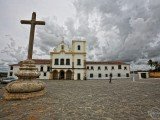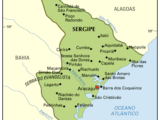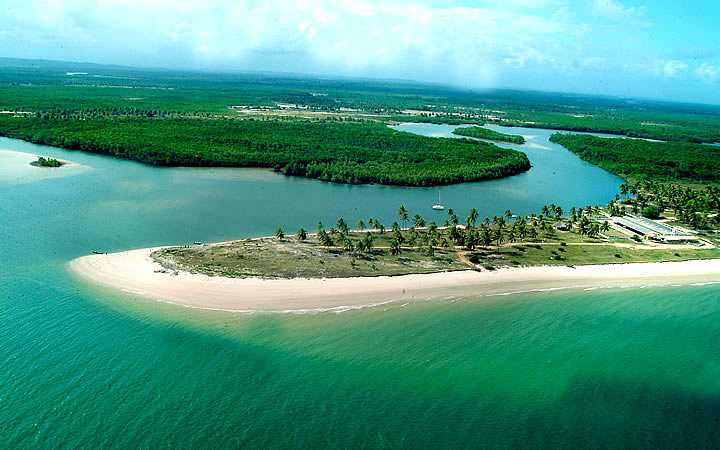Este post também está disponível em:
Português
English

Sergipe is the smallest of the Brazilian states and is an invitation to tourism for at least two reasons: the attractive prices and the combination of natural beauty and historical treasures.
The state of Sergipe lies in the Northeast region between the states of Bahia and Alagoas. Sergipe once belonged to Bahia, gaining autonomy as a federal unit in 1820.
From then on it began to develop its economy based on agricultural production (sugar cane, oranges and coconuts) and mineral extraction (oil, natural gas, limestone, potash, among others).
The name of the state is a tribute to one of the rivers that cuts it, the Sergipe River, which received this name from the Indians who inhabited the region.
Sergipe means river of siris and is the result of the contraction of the words siri, y, pe, in Tupi-Guarani.

The Tupis-Guaranis are one of the ethnic groups that inhabited the region. The others are Canindé and Aratu.
In general, Sergipe has very flat lands. Only in the region of Canindé de São Francisco and near the border with Bahia are there mountains and hills.
In the coastal region and in the canyon area it is hot and rains a lot, while in the hinterland the climate is semi-arid, with a lot of heat and long periods without rain. The average annual temperature throughout the state is 26ºC.
Of what nature offers, it would suffice to mention the “Velho Chico” canyon, in Caninde de São Francisco, considered the fifth largest in the world and the most navigable on the planet. About 200 kilometers from Aracaju, in Canindé do São Francisco, you will find one of the most stunning landscapes of Sergipe: the Cânion do Xingó.
In the historical ambit, São Cristovão, former capital of the state, founded at the end of the 16th century, preserves a beautiful architectural heritage.
Not to mention the folkloric festivals that evoke the traditional popular autos. Some have existed since the end of the 19th century, such as the reisado.
The capital of Sergipe, Aracaju, planned to host the state government – a post it has held since 1855 – the urbanized and bustling Atalaia waterfront and the Sergipe Memorial, for example, declare a potential to satisfy both types of interest.

The first one offers bars and restaurants that shake the Sergipe night. The memorial has a rich collection of pieces that attest to the history of the city.
Admirers of handicrafts will also find several fairs with pieces worked by local artists.
For those who enjoy the sertanejo rhythm, the capital promotes Forró Caju in June, which attracts thousands of people for almost two weeks.
Close to the capital, the city of Laranjeiras holds one of the monuments of greatest historical and religious value of Sergipe: the church of Nossa Senhora da Conceiҫão, dating from 1743.
Definitively separated from the captaincy of Bahia in 1823, the state was one of the places in the country where the indigenous people most resisted colonization in the 16th century. “Cirizipe” or “Cerigipe”, which means “crab sting” in Tupi, was the name of one of the indigenous leaders who fought strongly against the Portuguese.
Videos “Tourist Spots of Sergipe”


Sergipe - Guia de Turismo

O que fazer em Sergipe

Atrações turísticas de Sergipe

Sergipe - Guia de Turismo Completo

Litoral Sergipano25:49

Sergipe - Reportagem25:49
SERGIPE TOURIST POINTS
Sergipe is a tiny state, especially when compared to neighboring Bahia or states in the North region, such as Pará and Amazonas. But, despite the small territorial extension, it has many natural beauties.
- Atalaia beach, the most popular of Aracaju.
- The catamaran or schooner rides through the canyon of the São Francisco river, in Canindé do São Francisco.
- The historical center and the Museum of Sacred Art of São Cristovão.
- The beautiful architectural ensemble of the city of Laranjeiras, which arose at the end of the 16th century.
- South Coast of Sergipe attracts tourists in search of tranquility
- Ilha Croa do Goré is only available for six hours a day
- Praia Ponta dos Mangues in the Santa Isabel biological reserve
- Ilha de Santa Luzia is a refuge for surfers and fishermen
- Pirambu is a fishing center of the Northeast and also has beautiful beaches
- Praia do Saco is an option for those seeking tranquility
- Pantanal Sergipano em Pacatuba
- Park of the Falcons and Serra de Itabaiana
- Cânion do Xingó is paradise that is in the hinterland of Sergipe
WHEN TO GO TO SERGIPE
- In January, if you want to attend the folkloric presentations of the Cultural Meeting, which takes place in Laranjeiras and is a basic reference of northeastern popular art.
- To better enjoy the beach or walks along the São Francisco River, avoid the months when it rains the most (from April to July).
- In June, when the Forró Caju takes place, the highlight of the São João festivities.
Sergipe Tourism and Travel Guide



















